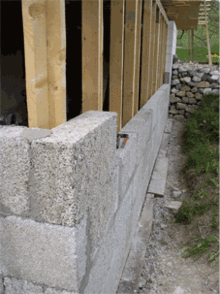Alternative natural materials
Alternative natural materials are
History
Alternative natural materials have existed for quite some time but often in very basic forms, or only as ingredients to a particular material. For example, earth used as a building material for walls of houses has existed for thousands of years. Much more recently, in the 1920s, the United States government promoted rammed earth as a fireproof construction method for building farmhouses.[1] Another more common example is adobe. Adobe homes are prominent in the southwestern U.S. and several Spanish-speaking countries.[2]
Structural materials
Rock
Rocks have two characteristics: good thermal mass and thermal insulation. The temperature in a house built from rock stays relatively constant, thus requiring less air conditioning and other cooling systems. Types of rocks that can be employed are reject stone (pieces of stone that are not able to be used for another task), limestone, and flagstone.[citation needed]

Bamboo
In Asian countries, bamboo is used for structures like bridges and homes. Bamboo is surprisingly strong and flexible and grows incredibly fast, making it an abundant material. Although it can be difficult to join corners together, bamboo's material strength makes up for the hardships that can be encountered while building with it.[citation needed]
Rammed earth
Rammed earth is a very abundant material that can be used in place of concrete and brick. Soil is packed tightly into wall molds where it is rammed together and hardened to form a durable wall packing made of nothing more than dirt, stones, and sticks.[3] Rammed earth also provides thermal mass, resulting in energy savings. In addition, it is very weatherproof and durable enough that it was used in the Great Wall of China.[citation needed]
Earth-sheltered
Insulation materials

Straw
Straw bales can be used as a basis for walls instead of drywall. Straw provides excellent insulation and fire resistance in a traditional post-and-beam structure, where a wood frame supports the house.[3] These straw walls are about 75% more energy efficient than standard drywall and because no oxygen can get through the walls, fire cannot spread and there is no chance of combustion.[citation needed]
Cordwood
Cork
Cork is suitable as thermal insulation, as it is characterized by lightness, elasticity, impermeability, and fire resistance. In construction, cork can be applied in various construction elements like floors, walls, roofs, and lofts to reduce the need for heating or cooling and to enhance energy efficiency.
Adobe
Adobe is an age-old technique that is cheap, easy to obtain, and ideal for hot environments. A mixture of sand, clay, and water is poured into a mold and left in the sun to dry. When dried, it is exceptionally strong and heat-resistant. Adobe does not let much heat through to the inside of the structure, thus providing excellent insulation during the summer to reduce energy costs. Although this clay mixture provides excellent insulation from heat, it is not very waterproof and can be dangerous in earthquake prone areas due to its tendency to crack easily.[citation needed]
Sawdust
Sawdust can be combined with clay or cement mixtures and used for walls. Such walls are very sturdy and the method effectively recycles any trees needing excavation from the building area. Depending what type of sawdust is used (hardwood is best) the wood chips in the walls absorb moisture and help prevent cracking during freeze and thaw cycles.[1] Sawdust may be combined with water and frozen to produce a material commonly known as pykrete, which is strong, and less prone to melting than regular ice.
Papercrete
Papercrete is a new material that serves as a good substitute for concrete. Papercrete is shredded paper, sand, and cement mixed together to form a very durable brick-like material. Buildings utilizing papercrete are well-insulated and resistant to termites and fire. Papercrete is very cheap as it usually only costs about $0.35 per square foot.[citation needed]
Hempcrete

Hempcrete, also known as hemplime, is a sustainable
Hempcrete gained popularity in France since the 1990s, and is used in Canada for various construction purposes, such as indoor temperature control, prefabricated panels, and diverse insulation needs with different density mixtures.[citation needed]
Examples
Although alternative building materials are a newer concept, some buildings have already employed these materials, as well as other tactics, in pursuit of greater sustainability.
- One such example is the School of Art, Media, and Design located in Singapore. This school has a roof made completely of grass (an example of Earth-sheltering).[4] This allows the use of less concrete and other materials for the roof, and the building also includes many windows to utilize natural lighting.
See also
- Green building
- Green building and wood
- Green roof
- Hemp as a building material
- Natural building
- Sustainable architecture
- Sustainable landscaping
- Sustainable landscape architecture
- Sustainable gardening
References
- ^ a b Taylor, Charmaine R. "Building for free with "alternative" natural materials". Archived from the original on 18 April 2009. Retrieved 2009-04-22.
- ^ a b Craven, Jackie. "Building With Natural Materials". Archived from the original on 2009-02-01. Retrieved 2009-04-22.
- ^ a b Edmonds, Molly. "Top 10 Natural Building Materials". Archived from the original on 2009-04-02. Retrieved 2009-04-23.
- ^ Kriscenski, Ali. "Amazing Green Roof Art School in Singapore". Archived from the original on 31 March 2009. Retrieved 2009-04-23.
